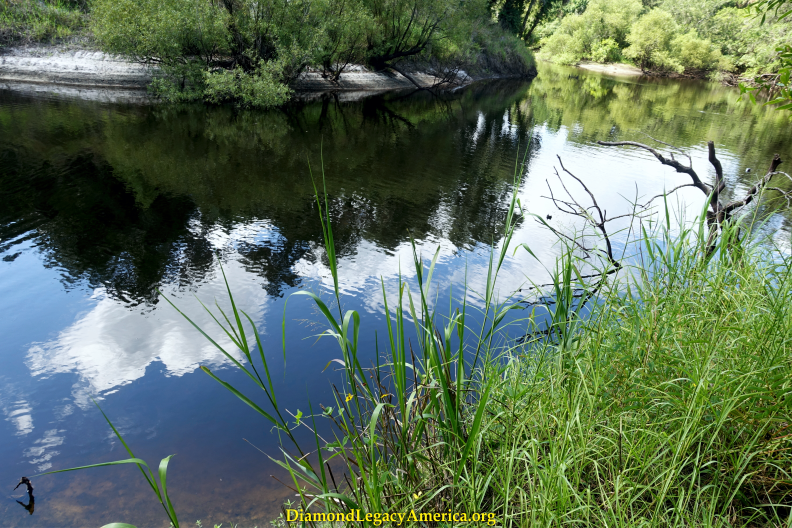Journey of Appreciation
Our journeys to honor the legacy of First Nation People continue throughout the northwest “Florida” territory…including Tallahassee (said to mean ‘old town’ in Muskogean languages). Specifically, we plan to experience the Aboriginal Mound which was occupied by the “Apalachee” people (ca 1450 A.D.), who were descendants of the Original Inhabitants of this land.
Archaeologists categorize this ancient group as part of the “Fort Walton culture” which is a variation of Mississippian “cultures” known for using and building large platform mounds. Obviously, this location has significance and we are inspired to learn more.
“Velda Mound“ was labeled after a modern-day dairy (Velda Farms Inc.) that began operations in the 1950s. This ancient mound near cascading water reportedly was a platform shaped structure where the Chief lived on top; houses with garden plots and shared farming fields surrounded the mound, forming the village; and it “functioned much like a town hall for people living in nearby countrysides” (quoted from the 'Archaeological Stabilization Guide').
Reportedly first identified in the 1950s by Charles Fairbanks, archaeologist/anthropologist, the mound was recorded to be “virtually destroyed by looting” and sadly--the significance (and quantity) of items stolen is incalculable. A 1968 excavation performed by Ross Morrell (formerly “Florida” State Archaeologist), revealed the mound site has clear association with a nearby village; and in 1995, ceramics and site features were studied by Archaeologist J. Scarry (unpublished report).
As stated in earlier research, the Ancient people inhabiting the northern territory were of a Mississippian “culture” and called themselves “Talahalwasi” (“Tallahassee”). Reportedly, this esteemed group, a.k.a. Apalachee, possessed a vast region known as “Apalachee Province” or “Anihaica” (meaning “Elite-place of” in Southern Arawak dialect). This province spanned from the Aucilla River (east) to the Apalachicola River (west); and the northern boundary likely extended into present-day “Georgia,” with the Gulf of Mexico being the southern boundary.
Aucilla River near “Tallahassee, Florida”
The Talahalwasi (Apalachee) have been described as Muskogean-speakers who represented the largest linguistic group that included the massive so-labeled Creek Confederacy (a coalition of many towns spanning “Georgia,” Alabama, and north “Florida”). Some linguists suggest this language has links to Arawakan or South American groups. Additionally, sources indicate there was an established “Georgia” town and group of people called “Apalache”, and whether or not they migrated to “Florida” is unknown. Also, studies of local artifact recoveries and decorative pottery reveal that the same style motifs were found at Mississippian tradition “sites” like Ocmulgee and Etowah at “Georgia” locations and Cahokia Mounds at “Illinois.”
Cahokia Mounds are said to be the largest and most impressive Mounds from the Mississippian Culture in Amexem, North America. The mound to the top left of images shows the largest Ancient Aboriginal Mound from a distance.
Fascinating research acknowledges that Mississippian “cultures” developed permanent towns centered around large earthen platform mounds that were enhanced periodically by other groups occupying the “sites” afterwards. Mounds were mostly quadrilateral in shape with ramps, stairs, and ladders leading to the top, where important structures were added--like houses for the Town Chiefs, buildings for ceremonies and meetings, and storage sheds for food and supplies to accommodate large populations.
We realize the importance of this ancestral monument based on its closeness to two other ancient mounds located around Lakes Okeeheepkee and Miccosukee. By the way, Okeeheepkee is a so-called “Creek” word meaning 'disappearing waters' and it is a sinkhole lake—one of many in the area including Lake Miccosukee.
Scenic view of Lake Miccosukee nearby Aboriginal, American Mounds
The Original Inhabitants of the northwest region established a legacy of ingenuity and innovation by respecting nature and showing appreciation for the abundance that sustains their existence.
We exude gratitude with every opportunity to acknowledge First Nation People for their extensive contributions to humanity and we embrace the capability to share some of these relevant aspects with you.
A large portion of our Journey of Appreciation at the “Mound near Cascading Water” is accessible in PDF format by clicking here. Thank you for your interest in sharing our experiences.





